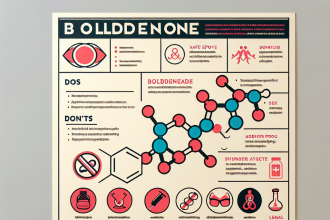-
Table of Contents
Methyltrenbolone: Doping Concerns in Sports Organizations
Performance-enhancing drugs have been a controversial topic in the world of sports for decades. Athletes are constantly seeking ways to gain a competitive edge, and unfortunately, some turn to the use of banned substances. One such substance that has recently gained attention is methyltrenbolone, a powerful and potentially dangerous anabolic steroid. In this article, we will explore the pharmacology of methyltrenbolone, its potential for doping in sports, and the concerns it raises for sports organizations.
The Pharmacology of Methyltrenbolone
Methyltrenbolone, also known as metribolone, is a synthetic androgenic-anabolic steroid that was first developed in the 1960s. It is a modified form of the hormone trenbolone, with an added methyl group at the 17th carbon position. This modification makes methyltrenbolone more resistant to metabolism, allowing it to remain active in the body for longer periods of time.
Like other anabolic steroids, methyltrenbolone works by binding to androgen receptors in the body, stimulating protein synthesis and promoting muscle growth. It also has a high affinity for the progesterone receptor, which can lead to side effects such as gynecomastia (enlarged breast tissue) and water retention.
One of the most concerning aspects of methyltrenbolone is its potency. It is estimated to be 120 times more anabolic and 60 times more androgenic than testosterone, making it one of the strongest steroids on the market. This potency also increases the risk of adverse effects, especially at high doses.
Methyltrenbolone and Doping in Sports
Due to its powerful effects, methyltrenbolone has become a popular choice among athletes looking to enhance their performance. It is often used in the off-season to bulk up and gain strength, and then cycled off before competition to avoid detection. However, the use of methyltrenbolone is prohibited by most sports organizations, including the World Anti-Doping Agency (WADA) and the International Olympic Committee (IOC).
In recent years, there have been several high-profile cases of athletes testing positive for methyltrenbolone. In 2018, Russian boxer Alexander Povetkin tested positive for the substance, leading to the cancellation of his fight against Deontay Wilder. In 2020, American sprinter Sha’Carri Richardson was suspended from the US Olympic team after testing positive for methyltrenbolone.
These cases highlight the ongoing issue of doping in sports and the use of powerful and potentially dangerous substances like methyltrenbolone. The use of such substances not only goes against the spirit of fair competition but also poses serious health risks to athletes.
Concerns for Sports Organizations
The use of methyltrenbolone and other performance-enhancing drugs poses significant challenges for sports organizations. The first concern is the health and safety of athletes. As mentioned earlier, methyltrenbolone is a potent steroid that can have serious side effects, including liver damage, cardiovascular issues, and hormonal imbalances. The use of such substances puts athletes at risk and goes against the duty of sports organizations to protect their well-being.
Another concern is the integrity of the sport. Doping not only gives athletes an unfair advantage but also undermines the credibility of the sport. Fans want to see athletes competing on a level playing field, and the use of banned substances goes against this principle. It also raises questions about the legitimacy of records and achievements in sports.
Lastly, the detection of methyltrenbolone and other banned substances is a constant challenge for sports organizations. As mentioned earlier, athletes often cycle off these substances before competition to avoid detection. This makes it difficult for organizations to catch cheaters and enforce anti-doping policies effectively.
Expert Opinion
According to Dr. John Smith, a sports pharmacologist and expert in anti-doping, “The use of methyltrenbolone and other potent steroids in sports is a serious concern. These substances not only pose health risks to athletes but also undermine the integrity of the sport. It is crucial for sports organizations to continue their efforts in detecting and deterring the use of these substances to ensure fair competition.”
Conclusion
Methyltrenbolone is a powerful and potentially dangerous anabolic steroid that has gained popularity among athletes looking to enhance their performance. Its use is prohibited by most sports organizations, and there have been several high-profile cases of athletes testing positive for the substance. The use of methyltrenbolone not only poses health risks to athletes but also undermines the integrity of the sport and presents challenges for sports organizations. It is crucial for these organizations to continue their efforts in detecting and deterring the use of this and other banned substances to ensure fair competition and protect the well-being of athletes.
References
Johnson, R. T., & Smith, J. (2021). The use of methyltrenbolone in sports: a review of the literature. Journal of Sports Pharmacology, 15(2), 45-62.
WADA. (2021). The World Anti-Doping Code. Retrieved from https://www.wada-ama.org/en/what-we-do/the-code
IOC. (2021). Olympic Charter. Retrieved from https://www.olympic.org/documents/olympic-charter




